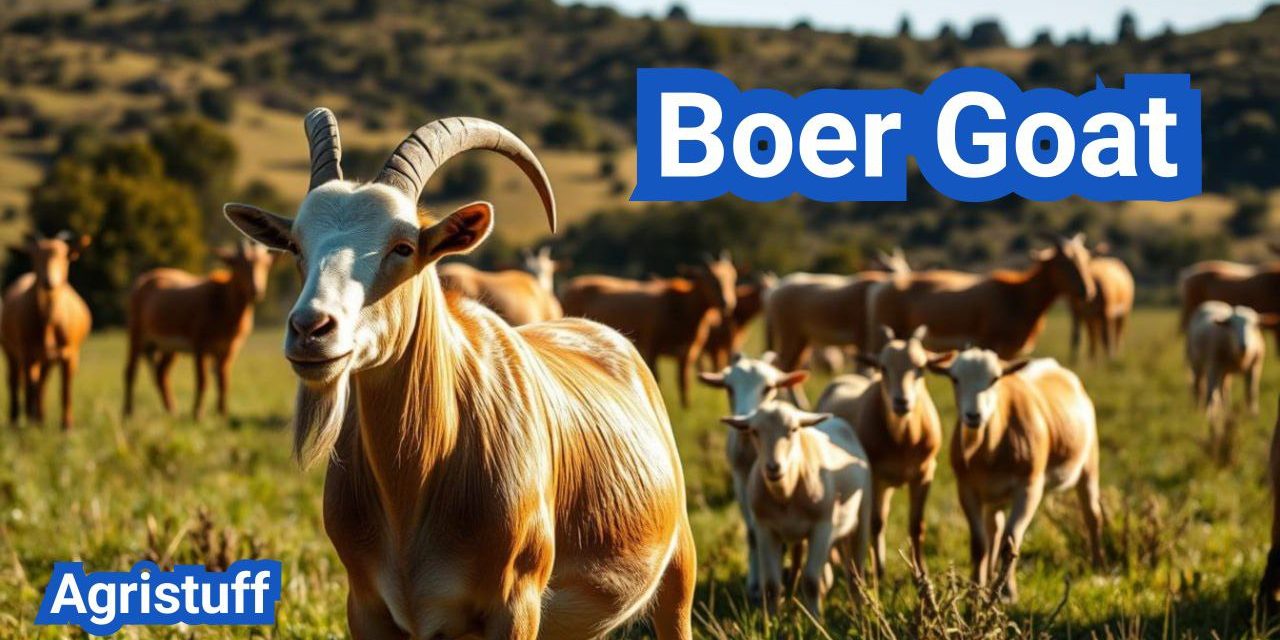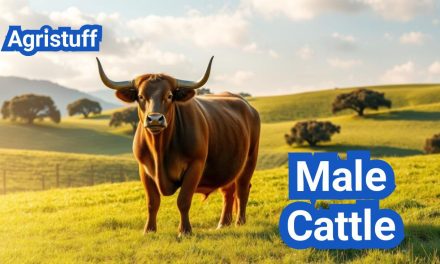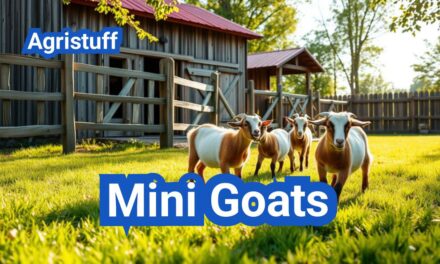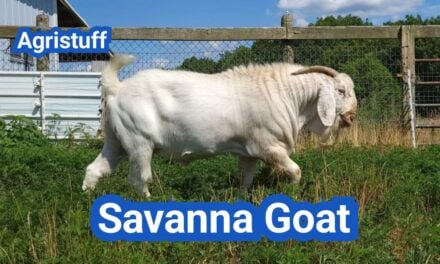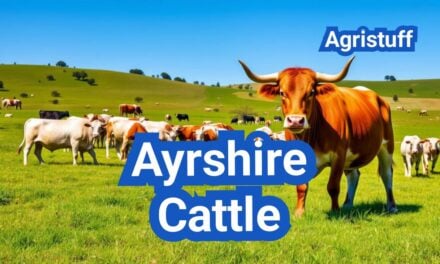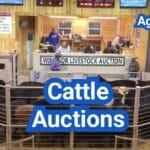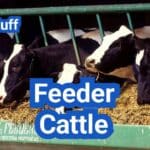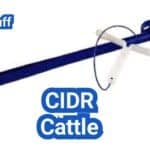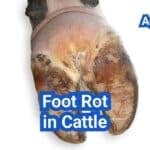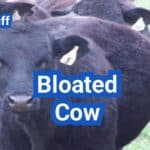The Boer goat is renowned for its exceptional characteristics that contribute to its profitability and value in agriculture. Originating in South Africa, this breed has become a leading choice in the meat goat industry due to its robust build and fast growth rate.
Known for its muscular build and high fertility, the meat goat breed is favored by breeders worldwide. Its size and weight vary, but it is generally larger than other breeds, making it a popular choice for meat production.
Key Takeaways
- The Boer goat is a leading breed in the meat goat industry.
- It is known for its robust build and fast growth rate.
- High fertility rates make it a popular choice among breeders.
- The breed’s size and weight are generally larger than other goat breeds.
- Boer goats are favored for their muscular build and profitability.
The Origin and History of the Boer Goat
With roots tracing back to South Africa, the Boer goat has evolved into a premier choice for meat goat farming. The breed’s history is a testament to its hardiness and adaptability, qualities that have made it a favorite among farmers worldwide.
South African Development and Heritage
The Boer goat originated in South Africa, where it was developed for its exceptional meat qualities and ability to thrive on the thorn veldt. The breed’s name “Boer” is derived from the Dutch word for “farmer,” reflecting its origins in South African agriculture. The Boer goat’s development involved selective breeding of local goats with imported breeds, resulting in a robust and resilient animal well-suited to the challenging South African environment.
Key characteristics of the Boer goat include its fast growth rate, muscular build, and resistance to disease. These traits were highly valued by South African farmers, who relied on the breed for meat production.
Introduction to North America
The Boer goat was introduced to North America in the early 20th century, marking the beginning of its global spread. The American Boer Goat Association was established to promote the breed and oversee its development in the United States. Today, the Boer goat is recognized as a leading breed in meat goat production, not only in North America but also globally.
| Year | Event | Significance |
|---|---|---|
| Early 20th Century | Introduction to North America | Global expansion of the breed |
| Establishment of ABGA | Formation of the American Boer Goat Association | Promotion and regulation of the breed in the USA |
| Present Day | Global recognition | Leading breed in meat goat production |
The history of the Boer goat is a story of successful breeding and adaptation, from its origins in South Africa to its current status as a global leader in meat production. Understanding this history is crucial for appreciating the breed’s value and potential in modern agriculture.
Boer Goat Physical Characteristics

Characterized by their robust build and distinctive features, Boer goats have become a staple in the meat goat industry. Their physical attributes play a significant role in their popularity among farmers and consumers alike.
Distinctive Breed Features
Boer goats are known for their muscular build and unique appearance. Mature bucks typically weigh between 200-340 pounds, while does weigh between 190-230 pounds. Their size and weight make them an ideal choice for meat production.
The breed’s distinctive features include a white body with a red head, although variations in color can occur. Their robust physique and strong legs enable them to thrive in various environments.
Growth Patterns and Maturation
Boer goats exhibit a rapid growth rate, especially during their early stages of development. Kids born with a healthy weight can gain up to 0.3-0.4 pounds per day, reaching market weight within a few months. This fast growth rate is one of the breed’s most appealing characteristics for producers.
The maturation process of Boer goats is also noteworthy. They reach breeding age relatively quickly, with does often being bred at around 7-8 months of age. Proper nutrition and management are crucial during this period to ensure optimal growth and development.
Understanding the physical characteristics of Boer goats is essential for farmers to make informed decisions about their breeding and production strategies. By leveraging the breed’s strengths, producers can optimize their operations for better outcomes.
Weight and Size Standards for Meat Production
The Boer goat breed is renowned for its exceptional growth rate, making it a prime choice for meat production. Boer goats are bred to achieve significant weight and size, which are crucial factors for farmers looking to maximize their returns in the meat production market.
Boer goats are known for their substantial size and rapid growth rate. The breed standards for Boer goats dictate that they should have a sturdy build and a robust body, capable of achieving considerable weight in a relatively short period.
Ideal Market Weights
For Boer goats raised for meat production, achieving the ideal market weight is crucial. The ideal market weight varies depending on the target market and production goals. Generally, Boer goats are considered ready for market when they reach a weight between 80 to 120 pounds (36 to 54 kg), although this can vary.
- Market Weight Range: 80-120 pounds (36-54 kg)
- Optimal Age for Slaughter: Typically between 6 to 9 months
- Factors Influencing Market Weight: Genetics, nutrition, and management practices
Growth Rate Expectations
The growth rate of Boer goats is one of their most attractive features for meat producers. Boer goats are capable of achieving average daily gains of 0.3 to 0.4 pounds (0.14 to 0.18 kg) under proper feeding and management conditions.
To maximize growth rates, farmers should focus on providing high-quality nutrition and implementing effective management practices. This includes:
- Ensuring access to high-quality feed and forage
- Implementing a balanced feeding program tailored to the goats’ nutritional needs
- Maintaining a healthy environment through proper health care and sanitation practices
By understanding and managing the factors that influence growth rate and market weight, farmers can optimize their Boer goat production systems to achieve better profitability.
Color Varieties and Breed Classifications

One of the distinguishing features of Boer goats is their varied coloration, which includes several recognized patterns. The diversity in their appearance is not only visually appealing but also plays a significant role in their breed classification.
Traditional White Body with Red Head
The most iconic color pattern for Boer goats is the traditional white body with a red head. This distinctive coloring is a hallmark of the breed and is often associated with the original South African stock from which the Boer goat was developed.
Solid and Painted Varieties
While the red head and white body are characteristic, Boer goats also come in solid colors and painted varieties. Solid colors can range from completely white to red, black, or other hues. Painted Boer goats display a mix of colors, creating a unique appearance.
Key characteristics of solid and painted Boer goats include:
- Uniform color distribution in solid varieties
- Distinct patches or markings in painted varieties
- A wide range of colors and combinations
Dappled and Spotted Patterns
In addition to solid and painted patterns, Boer goats can also exhibit dappled and spotted patterns. Dappled goats display a mottled or blotchy appearance, while spotted goats have distinct spots.
These color variations contribute to the breed’s overall diversity and are recognized within the breed classifications. Understanding these patterns is essential for breeders and enthusiasts alike.
How to Set Up Your Boer Goat Farm
Setting up a Boer goat farm is a multi-step process that involves planning, land preparation, and infrastructure development. For beginners, raising Boer goats can be a rewarding experience, but it requires careful consideration of several key factors.
Land Requirements and Fencing
The first step in establishing a Boer goat farm is selecting the right land. Boer goats require substantial grazing areas, so you’ll need enough land to support your herd. The land should be well-drained and have adequate vegetation. Fencing is also crucial as it helps to keep your goats safe and contained. A sturdy fence should be at least 5 feet tall to prevent escape and predator entry.
Housing and Shelter Design
Boer goats need shelter to protect them from extreme weather conditions. The shelter should be well-ventilated, dry, and free from drafts. You can design the shelter according to your farm’s specific needs, but it should provide enough space for your goats to stand, turn around, and lie down comfortably.
Consider the following when designing housing:
- Provide adequate ventilation to prevent respiratory issues.
- Ensure the shelter is dry and free from moisture.
- Use bedding materials like straw or sand to keep the area clean and dry.
Equipment and Supply Checklist
To manage your Boer goat farm efficiently, you’ll need various equipment and supplies. These include:
- Feeding equipment: feeders, waterers, and hay racks.
- Health supplies: vaccinations, medications, and first aid kits.
- Fencing materials: posts, wire, and gates.
- Handling equipment: chutes, gates, and sorting panels.
Having the right equipment and supplies on hand will help you manage your farm more effectively and ensure the health and well-being of your goats.
Step-by-Step Guide to Raising Boer Goats

A step-by-step approach is essential for raising Boer goats effectively. This guide will walk you through the critical stages of Boer goat farming, from selecting your initial stock to managing your herd on a daily basis.
Selecting Your First Goats
Choosing the right Boer goats for your farm is crucial. Consider factors such as the goats’ age, health, and breed quality. It’s advisable to start with goats that are already adapted to your local climate.
Key considerations include purchasing from reputable breeders and ensuring the goats are up-to-date on vaccinations and health checks.
- Age: Kids or young adults are often preferred for starting a new herd.
- Health: Look for goats with a robust health record.
- Breed Quality: Ensure the goats conform to Boer breed standards.
Establishing Your Herd
Once you’ve selected your initial goats, the next step is to establish your herd. This involves integrating new goats into your existing flock (if any) and ensuring they have adequate space and resources.
Effective herd management includes monitoring the goats’ health, managing their nutrition, and maintaining proper fencing to prevent escape or predation.
Daily Management Routine
A daily management routine is vital for the health and productivity of your Boer goats. This routine should include feeding, health checks, and monitoring their living conditions.
Daily tasks may involve:
- Feeding: Provide a balanced diet that meets their nutritional needs.
- Health Checks: Monitor for signs of illness or stress.
- Living Conditions: Ensure their enclosures are clean and safe.
By following this step-by-step guide, you can ensure a thriving Boer goat farm.
Essential Health Care Protocols
Boer goats, known for their hardiness, still require diligent health care to thrive. A comprehensive health care program is crucial for preventing diseases and ensuring the overall well-being of the goats.
Preventative Health Program
A preventative health program is the cornerstone of maintaining a healthy Boer goat herd. This includes regular vaccinations, parasite control measures, and hoof care. Vaccinations should be administered according to a schedule recommended by a veterinarian, taking into account the specific diseases prevalent in your area.
Parasite control is another critical aspect, as internal parasites can significantly impact the health and productivity of your goats. Regular monitoring and appropriate treatments are essential.
Common Health Issues and Solutions
Despite preventative measures, Boer goats can still be susceptible to certain health issues. Common problems include respiratory infections, parasites, and reproductive issues. Respiratory infections can be managed with proper ventilation in housing and timely veterinary intervention.
- Regularly inspect your goats for signs of illness or stress.
- Maintain a clean and dry living environment to reduce the risk of disease.
- Provide a balanced diet to support immune function.
When to Call the Veterinarian
Knowing when to seek veterinary care is crucial for the health of your Boer goats. If you observe signs of severe illness, such as difficulty breathing, lethargy, or loss of appetite, it’s essential to contact a veterinarian promptly. Early intervention can significantly improve outcomes in many cases.
Nutrition and Feed Management

A balanced diet is fundamental to the success of Boer goat farming operations. Boer goats require a well-balanced diet that includes high-quality pasture and supplemental feeding to ensure optimal health and productivity.
Formulating Balanced Rations
Formulating balanced rations for Boer goats involves understanding their nutritional needs at different stages of their life cycle. The nutritional requirements vary based on factors such as age, size, and production stage.
| Nutrient | Requirement | Feed Source |
|---|---|---|
| Protein | 12-18% | Legume hay, grains |
| Energy | 2.5-3.0 Mcal/kg | Grains, corn |
| Calcium | 0.6-0.8% | Limestone, alfalfa hay |
| Phosphorus | 0.3-0.4% | Phosphorus supplements |
As noted by agricultural experts, “A well-formulated diet is crucial for maintaining the health and productivity of Boer goats.”
“The nutritional needs of goats are complex and vary with the stage of production. A diet that is adequate in energy, protein, and minerals is essential for optimal performance.”
Pasture Development for Boer Goats
Pasture development is a critical component of Boer goat nutrition. High-quality pastures provide the necessary nutrients for optimal growth and production.
Effective pasture management involves rotational grazing to maintain pasture quality and prevent overgrazing. This approach ensures that the goats have access to fresh forage throughout the grazing season.
Supplemental Feeding Strategies
Supplemental feeding is often necessary to ensure that Boer goats receive a balanced diet, especially during periods of poor pasture quality or when nutritional demands are high.
- Provide high-quality hay during periods of low pasture quality.
- Use grains and concentrates to meet energy and protein requirements.
- Ensure access to clean water at all times.
By implementing these strategies, Boer goat farmers can optimize the nutritional intake of their animals, leading to improved health and productivity.
Implementing Successful Breeding Programs

To achieve success in Boer goat farming, implementing a well-structured breeding program is essential. A successful breeding program can significantly enhance the productivity and quality of your Boer goat herd.
Selecting Quality Breeding Stock
The foundation of any successful breeding program is the selection of quality breeding stock. When selecting breeding stock, consider factors such as genetic diversity, growth rate, and fertility. Look for animals with a strong pedigree and desirable traits that align with your breeding goals.
- Evaluate the genetic history of potential breeding animals.
- Assess their physical condition and health status.
- Consider their growth rate and maturity.
Breeding Season Management
Effective breeding season management is critical for maximizing the productivity of your Boer goat breeding program. This involves planning the breeding season to coincide with optimal kidding times and ensuring that your does are in the best possible condition for breeding.
Key considerations include:
- Synchronizing estrus cycles to facilitate a compact kidding season.
- Ensuring bucks are fertile and in good health.
- Monitoring the breeding process closely.
Kidding Management
Kidding management is a crucial aspect of a successful breeding program. Proper care during the kidding season can significantly impact the survival rate and health of newborn kids.
Best practices include:
- Providing a clean and safe environment for kidding.
- Monitoring does closely during kidding.
- Ensuring newborn kids receive adequate colostrum and nutrition.
Strategic Crossbreeding with Boer Goats
By incorporating Boer goats into crossbreeding programs, farmers can capitalize on the breed’s renowned meat production capabilities. Crossbreeding Boer goats with other breeds can improve meat production and quality, making it a valuable strategy for farmers looking to enhance their operation’s efficiency.
Popular Boer Crosses and Their Advantages
Boer goat crossbreeding has gained popularity due to its numerous benefits. Some of the most common Boer crosses include:
- Boer x Spanish – Known for improved growth rates and hardiness.
- Boer x Kiko – Recognized for enhanced parasite resistance and overall vigor.
- Boer x Nubian – Valued for its milk production capabilities in addition to meat production.
These crosses combine the desirable traits of the Boer goat, such as fast growth rate and muscular build, with other beneficial characteristics from the other breeds, resulting in a more robust and productive herd.
Designing a Crossbreeding System
Designing an effective crossbreeding system involves several key considerations. First, farmers must identify their production goals and choose breeds that complement the Boer goat in achieving those goals. Factors such as climate, available resources, and market demands should also be taken into account.
A well-designed crossbreeding program can lead to significant improvements in productivity and profitability. It’s essential to:
- Select breeds with complementary strengths.
- Maintain accurate records of breeding, kidding, and growth rates.
- Continuously evaluate the performance of crossbred animals.
Evaluating Crossbred Performance
Evaluating the performance of crossbred animals is crucial to the success of a crossbreeding program. Key performance indicators include growth rate, fertility, and survival rate. By monitoring these metrics, farmers can make informed decisions about which crosses are most beneficial for their operation.
The benefits of boer goat crossbreeding are numerous, and when done correctly, it can lead to improved meat quality, increased productivity, and enhanced profitability. By understanding the advantages of different Boer crosses and carefully designing a crossbreeding system, farmers can maximize the benefits of their goat farming operation.
Miniature vs. Full-Size Boer Goat Production

Boer goat production encompasses both miniature and full-size animals, each with unique advantages. The decision between raising miniature or full-size Boer goats depends on various factors, including market demand, available land, and production goals.
Mini Boer Development and Standards
Miniature Boer goats, often referred to as “mini Boers,” have been developed to retain the characteristics of full-size Boer goats but in a smaller frame. These goats are not simply smaller versions of full-size Boers; they have been bred to maintain a proportional size while offering the same meat production qualities.
The standards for miniature Boer goats vary, but generally, they are characterized by their smaller stature, typically weighing between 50 to 100 pounds at maturity, compared to the 200 to 300 pounds or more of their full-size counterparts.
Market Opportunities for Different Sizes
The market opportunities for miniature and full-size Boer goats differ based on consumer preferences and production systems. Full-size Boer goats are often preferred for large-scale meat production due to their size and growth rate, making them ideal for commercial operations.
Miniature Boer goats, on the other hand, offer niche market opportunities, particularly for smaller farms or for consumers looking for smaller portions of goat meat. They are also popular as pets or for hobby farming due to their manageable size.
| Characteristics | Miniature Boer Goats | Full-Size Boer Goats |
|---|---|---|
| Mature Weight | 50-100 pounds | 200-300 pounds |
| Market Demand | Niche markets, pet/hobby farming | Commercial meat production |
| Land Requirements | Less land required | More land required |
Management Differences Between Sizes
Managing miniature Boer goats differs from managing full-size Boer goats in several key areas. Miniature goats require less feed and space, making them more suitable for smaller properties or for farmers with limited resources.
However, both sizes require similar care in terms of health management and nutrition. The key difference lies in the scale of operations and the specific market they cater to.
In conclusion, both miniature and full-size Boer goats have their place in the market, and the choice between them should be based on the farmer’s goals, resources, and target market.
Sustainable Meat Goat Production Practices

Sustainable meat goat production practices are not only beneficial for the environment but also contribute to the overall health and productivity of the farm. As the demand for goat meat continues to grow, farmers are looking for ways to produce meat in a more sustainable and environmentally friendly manner.
Environmentally Conscious Management
Environmentally conscious management is crucial in sustainable meat goat production. This involves implementing practices that minimize the farm’s ecological footprint. One such practice is rotational grazing, which helps maintain pasture health, reduces erosion, and promotes biodiversity.
By rotating goats through different pastures, farmers can ensure that the land is not overgrazed, allowing it to recover and maintain its productivity over time. This practice also helps in distributing nutrients more evenly across the pasture, reducing the need for synthetic fertilizers.
Reducing Environmental Impact
Reducing environmental impact is another key aspect of sustainable meat goat production. This can be achieved through various means, including the use of renewable energy sources, efficient water management systems, and minimizing waste.
For instance, implementing a rainwater harvesting system can significantly reduce a farm’s water consumption, making it more resilient during droughts. Additionally, using solar or wind power can decrease reliance on fossil fuels, lowering the farm’s carbon footprint.
Organic and Natural Production Options
Organic and natural production options are gaining popularity among consumers who are willing to pay a premium for products that are produced without synthetic chemicals or genetically modified organisms (GMOs). Meat goat farmers can benefit from these trends by adopting organic or natural production methods.
Organic certification requires adherence to strict guidelines, including the use of organic feed, avoidance of synthetic pesticides and fertilizers, and maintaining high standards of animal welfare. While the transition to organic production can be challenging, it offers opportunities for farmers to differentiate their products and access niche markets.
| Practice | Benefits | Implementation Steps |
|---|---|---|
| Rotational Grazing | Maintains pasture health, reduces erosion, promotes biodiversity | Divide pasture into sections, rotate goats regularly, monitor pasture condition |
| Renewable Energy | Reduces carbon footprint, lowers energy costs | Assess energy needs, install solar panels or wind turbines, maintain equipment |
| Organic Production | Access premium markets, improves animal welfare, reduces chemical use | Understand organic standards, transition land and practices, obtain certification |
Processing and Marketing Boer Goat Meat

As a leading meat goat breed, Boer goats are prized for their high-quality meat. The processing and marketing of this meat involve several critical steps, from ensuring superior meat quality characteristics to developing effective marketing channels.
Meat Quality Characteristics
Boer goat meat is known for its tenderness, lean profile, and rich flavor. These characteristics make it highly sought after in various culinary traditions. The meat quality is influenced by factors such as genetics, nutrition, and handling practices.
Nutritional Profile: Boer goat meat is not only delicious but also nutritious, offering a good source of protein, vitamins, and minerals while being relatively low in fat.
Harvesting and Processing Steps
The process of harvesting and processing Boer goat meat requires careful attention to detail to maintain its quality. This involves humane handling, proper slaughtering techniques, and meticulous processing to ensure the meat is safe for consumption and meets market standards.
- Humane handling and slaughtering practices
- Proper evisceration and carcass handling
- Meat processing and packaging
- Quality control measures
| Processing Step | Description | Importance |
|---|---|---|
| Humane Slaughtering | Ensuring goats are slaughtered humanely | High |
| Meat Processing | Processing meat for distribution | High |
| Quality Control | Checking meat for quality and safety | High |
Developing Marketing Channels
Effective marketing is crucial for the success of Boer goat meat producers. This involves identifying target markets, developing a brand, and creating sales channels. Producers can market their products directly to consumers, restaurants, or through distributors.
Marketing Strategies: Utilizing online platforms, participating in farmers’ markets, and engaging in local food promotions can help increase visibility and demand for Boer goat meat.
Analyzing Boer Goat Market Prices and Profitability
Understanding the dynamics of Boer goat market prices is crucial for farmers looking to maximize their profitability. The Boer goat industry is influenced by a variety of factors that impact market prices and overall profitability.
Current Market Trends in the USA
The current market trends for Boer goats in the USA show a fluctuating demand influenced by consumer preferences, export opportunities, and the overall economic situation. Farmers need to stay informed about these trends to make informed decisions about their breeding and selling strategies.
Recent data indicates that the demand for Boer goats is on the rise, driven by the increasing popularity of goat meat. This trend presents an opportunity for farmers to capitalize on the growing market.
Calculating Production Costs
To determine profitability, it’s essential to accurately calculate production costs. These costs include feed, veterinary care, labor, and equipment expenses. Efficient management practices can help reduce these costs and improve overall profitability.
A detailed breakdown of production costs will enable farmers to identify areas where they can cut expenses without compromising the health and quality of their Boer goats.
Strategies for Maximizing Profit
Maximizing profit in the Boer goat business involves a combination of effective breeding strategies, efficient production practices, and savvy marketing. Farmers should focus on producing high-quality animals that meet market demands.
- Improving breeding stock quality
- Optimizing feeding strategies
- Developing a robust marketing plan
By implementing these strategies, farmers can enhance their profitability and maintain a competitive edge in the market.
The Future of Boer Goat Farming
The Boer goat breed is expected to continue playing a significant role in the meat goat industry, particularly in the USA, where boer goat farming has gained popularity.
As discussed, the breed’s distinctive physical characteristics, growth patterns, and adaptability make it an ideal choice for meat production. With the right management practices, including proper nutrition, health care, and breeding programs, Boer goat farmers can achieve high productivity and profitability.
The future of boer goat farming looks promising, driven by increasing demand for goat meat and the breed’s potential for sustainable production. By adopting environmentally conscious management practices and exploring new market opportunities, farmers can capitalize on the growing demand for Boer goat products.
As the industry continues to evolve, it’s essential for farmers to stay informed about best practices, market trends, and emerging opportunities in boer goat farming to remain competitive.
FAQ
What is the origin of the Boer goat breed?
The Boer goat breed originated in South Africa, where it was developed for its hardiness and meat production capabilities.
What are the distinctive physical characteristics of Boer goats?
Boer goats are known for their white body with a red head, but they can also be found in solid, painted, dappled, and spotted varieties. They are characterized by their muscular build and robust bone structure.
What is the ideal market weight for Boer goats?
The ideal market weight for Boer goats varies, but typically, they are marketed between 80 to 120 pounds, with an average daily gain of 0.3 to 0.5 pounds.
How do I set up a Boer goat farm?
Setting up a Boer goat farm requires careful planning, including land preparation, fencing, housing, and equipment. It’s essential to ensure adequate space, shelter, and facilities for the goats.
What are the nutritional needs of Boer goats?
Boer goats require a balanced diet that includes high-quality forage, grains, and minerals. Their nutritional needs vary depending on their age, size, and stage of production.
How do I implement a successful breeding program for Boer goats?
A successful breeding program involves selecting quality breeding stock, managing the breeding season, and ensuring proper kidding management. It’s crucial to monitor the health and fertility of the breeding stock.
What are the benefits of crossbreeding with Boer goats?
Crossbreeding with Boer goats can improve the hardiness, growth rate, and meat production of the offspring. Popular crosses include Boer x Kiko and Boer x Nubian.
How do I manage the health of my Boer goat herd?
Managing the health of a Boer goat herd involves implementing a preventative health program, monitoring for common health issues, and seeking veterinary care when necessary.
What are the market trends for Boer goat meat in the USA?
The market trends for Boer goat meat in the USA vary, but there is a growing demand for lean, high-quality meat. Producers can capitalize on this trend by producing high-quality goats and developing effective marketing channels.
How do I calculate the production costs for my Boer goat operation?
Calculating production costs involves considering factors such as feed, labor, veterinary care, and equipment. Producers should regularly review their costs to ensure they are maximizing their profit.
What are the benefits of sustainable meat goat production practices?
Sustainable meat goat production practices, such as environmentally conscious management and organic production, can improve the long-term viability of the operation and appeal to environmentally aware consumers.
What is the difference between miniature and full-size Boer goat production?
Miniature Boer goats are smaller and may require different management practices than full-size Boer goats. They can be marketed to niche consumers looking for smaller, more manageable goats.
Boer Goat: Overview
Introduction to the Boer Goat
The Boer goat stands as the premier meat goat breed globally, renowned for its exceptional growth rate, muscular build, and adaptability. Originating in South Africa, these robust goats have become the backbone of sustainable meat goat farming in the USA. Whether you’re a hobby farmer or a commercial producer, understanding the Boer goat’s unique characteristics can help you maximize your herd’s potential.
This comprehensive guide explores everything from Boer goat farming in the USA to breeding strategies, feeding needs, and market opportunities—ensuring you have the knowledge to succeed.
External Reference: American Boer Goat Association (ABGA)
Why the Boer Goat Dominates Meat Production
Unmatched Growth Rate and Meat Yield
The Boer goat is the best meat goat breed for farmers seeking rapid returns. These goats can reach a market weight of 60-90 pounds in just 3-4 months, thanks to their superior feed efficiency and muscle development. Their meat is lean, tender, and highly sought after in specialty markets, making them a profitable choice for sustainable meat goat farming.
External Reference: USDA Meat Goat Production Guide
Hardiness and Low-Maintenance Care
Unlike other livestock, Boer goats thrive in diverse climates—from the humid Southeast to the arid Southwest. Their resistance to parasites and ability to graze on rough forage make them ideal for low-input farming systems.
External Reference: Oklahoma State University – Boer Goat Characteristics
Starting Your Boer Goat Farm
Choosing High-Quality Breeding Stock
For beginners, selecting the right Boer goats is crucial. Look for:
- Strong, muscular build (wide chest, thick legs)
- Good body condition (not too fat or thin)
- ABGA registration (ensures genetic quality)
Investing in premium breeding stock improves herd productivity and marketability.
External Reference: Goat Journal – Buying Boer Goats
Essential Housing and Fencing Setup
Boer goats require secure housing and fencing to prevent escapes and predator attacks:
- Shelter: Dry, well-ventilated, and spacious (minimum 15 sq ft per goat).
- Fencing: Woven wire or electric fencing (at least 4 feet high).
External Reference: Penn State Extension – Goat Housing Tips
Optimal Nutrition for Boer Goats
Understanding Boer Goat Feed Requirements
A balanced diet ensures rapid growth and reproduction:
- Forage: Pasture, alfalfa hay, and browse (60-70% of diet).
- Grain Supplement: 14-16% protein feed for kids and lactating does.
- Minerals: Free-choice goat minerals (must include copper and selenium).
Overfeeding grain can cause bloat, so introduce supplements gradually.
External Reference: NC State Extension – Goat Nutrition Guide
Water and Health Management
Clean water is critical—Boer goats drink 1-3 gallons per day, especially in summer. Key health practices include:
- Regular hoof trimming (every 2-3 months).
- Vaccinations (CD&T, rabies).
- Parasite control (rotational deworming).
External Reference: American Consortium for Small Ruminant Parasite Control
Boer Goat Breeding Strategies
Natural Breeding vs. Artificial Insemination
- Natural Breeding: 1 buck per 25-30 does; breed in fall for spring kidding.
- AI (Artificial Insemination): Access elite genetics but requires expertise.
Boer goat crossbreeding benefits include hybrid vigor—crossing with Kiko or Spanish goats enhances hardiness.
External Reference: Langston University – Goat Breeding Research
Managing Pregnancy and Kidding
Gestation lasts 150 days (5 months). Best practices include:
- Increasing protein in late pregnancy.
- Providing a clean, dry kidding pen.
- Monitoring for dystocia (rare in Boers due to easy kidding).
External Reference: Texas A&M AgriLife – Goat Kidding Guide
Marketing Boer Goats for Profit
Boer Goat Meat Market Prices
Demand peaks during cultural holidays (Easter, Eid). Current pricing trends:
- Live weight: $2.50-$4.50/lb.
- Processed meat: $8-$15/lb.
Ethnic markets, farmers’ markets, and online sales offer the best returns.
External Reference: USDA Livestock Market News
Selling Breeding Stock and Show Goats
Registered Boer goats with strong pedigrees can sell for $500-$5,000+. ABGA shows increase value through proven genetics.
External Reference: ABGA Show Results and Listings
Final Thought
The Boer goat remains the top choice for sustainable meat goat farming due to its rapid growth, hardiness, and strong market demand. By following best practices in nutrition, breeding, and marketing, farmers can build a profitable operation.
Whether you’re new to raising Boer goats for beginners or expanding an established herd, this guide provides the essential knowledge for success. Focus on quality genetics, proper care, and strategic sales to maximize your Boer goat farming in the USA venture.
External Reference: Sustainable Agriculture Research & Education (SARE)
Conclusion of: Boer Goat
Boer goat farming has become a cornerstone of the U.S. meat goat industry. Renowned for their fast growth, muscular build, and adaptability to various climates, Boer goats are the breed of choice for farmers looking to raise high-quality meat goats. This comprehensive guide explores Boer goat characteristics, care essentials, breeding insights, and economic advantages for U.S. farmers.
What Is a Boer Goat?
A Boer goat is a meat-specific goat breed originally from South Africa. Known for its white body and distinctive red head, the Boer goat stands out for rapid weight gain, strong bone structure, and a calm temperament—making it highly popular among meat goat producers in the United States.
Why Boer Goats Are Popular in the U.S.
Boer goats are preferred because of:
- Fast growth rates and high carcass yield
- Strong disease resistance
- Adaptability to various grazing conditions
- Favorable temperament for handling
Physical Characteristics of Boer Goats
Key features of Boer goats include:
- White bodies with solid red or brown heads
- Long, pendulous ears
- Muscular, compact frames
- Mature weight: Bucks (males) 240–300 lbs, Does (females) 190–230 lbs
Growth Rate and Meat Quality
Boer goats are known for:
- Reaching market weight in 6–9 months
- Producing tender, lean meat
- High dressing percentage (carcass weight vs. live weight)
This makes them ideal for commercial meat production in both large and small operations.
Breeding and Reproductive Traits
Boer goats excel in reproduction:
- High fertility rates
- Multiple births common (twins and triplets)
- Strong maternal instincts in does
- Year-round breeding capability in many U.S. regions
Feeding and Nutrition for Boer Goats
To maintain growth and health, Boer goats require:
- Quality pasture and browse
- Hay supplementation during winter months
- Grain concentrates for optimal growth rates
- Free-choice minerals and salt blocks
- Access to fresh, clean water at all times
Housing and Farm Setup
Boer goats thrive with:
- Secure fencing (woven wire or electric)
- Dry, ventilated shelters
- Separate kidding (birthing) areas
- Rotational grazing systems for pasture management
Health Management in Boer Goats
Routine care includes:
- Vaccinations (CDT is essential)
- Deworming to manage internal parasites
- Hoof trimming every 6–8 weeks
- Monitoring for diseases like pneumonia, pinkeye, and foot rot
Economic Benefits of Raising Boer Goats
Farmers choose Boer goats because:
- They command higher prices per head than many other goat breeds
- There is consistent market demand in U.S. ethnic and specialty meat markets
- They have strong feed-to-meat conversion efficiency
- They offer reliable reproductive performance
Marketing Boer Goat Meat
Common market channels for Boer goats include:
- Livestock auctions
- Direct sales to consumers
- Contracts with ethnic grocers or restaurants
- Online farm marketplaces
Crossbreeding with Boer Goats
Boer goats are often crossbred with breeds like Kiko or Spanish goats to:
- Enhance parasite resistance
- Improve growth rate and meat quality
- Strengthen adaptability to specific climates
Sustainable Farming and Boer Goats
Boer goats support sustainable agriculture through:
- Brush control and land clearing
- Efficient grazing management
- Lower environmental impact compared to larger livestock
Pros of Raising Boer Goats
- Fast growth rates
- High meat yield
- Strong market demand
- Ease of handling
Cons of Raising Boer Goats
- Requires careful parasite management
- Higher initial purchase cost than some other breeds
- Needs secure fencing to prevent escapes
Finally
Boer goat farming offers American livestock producers a dependable path to profitable, sustainable meat production. Their superior growth rates, adaptability, and consistent market demand make Boer goats a smart choice for both new and experienced goat farmers. By focusing on proper breeding, feeding, and health care, farmers can build long-term success around this leading meat goat breed.

